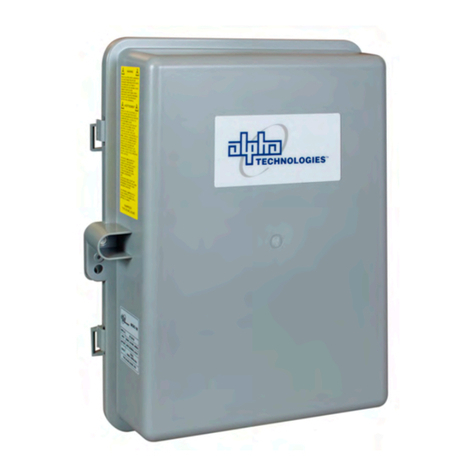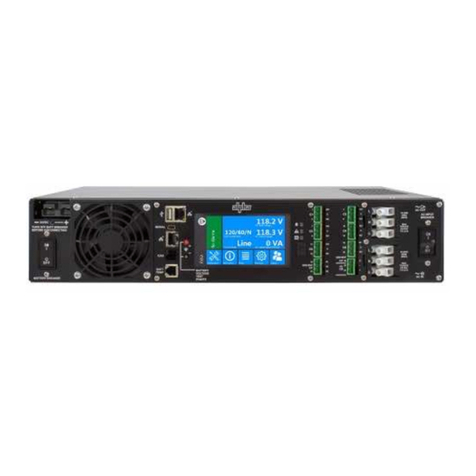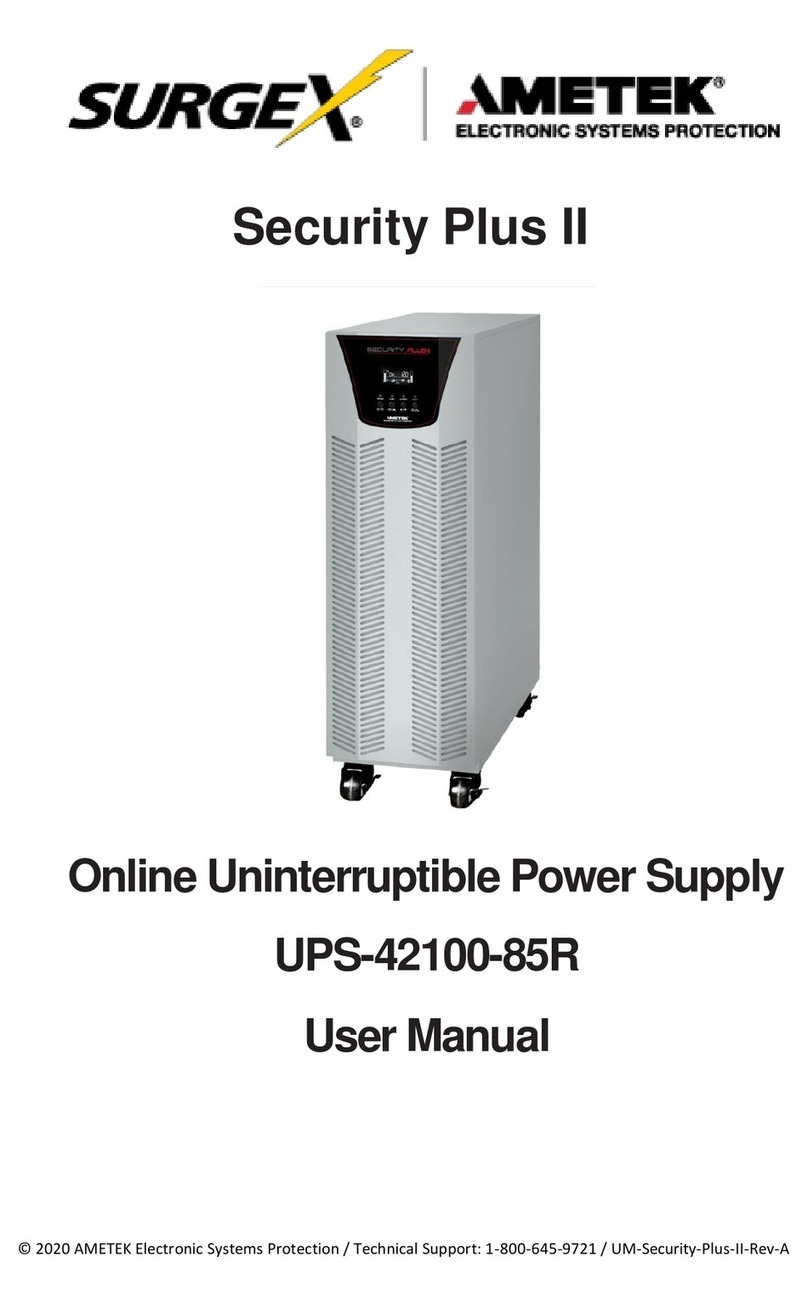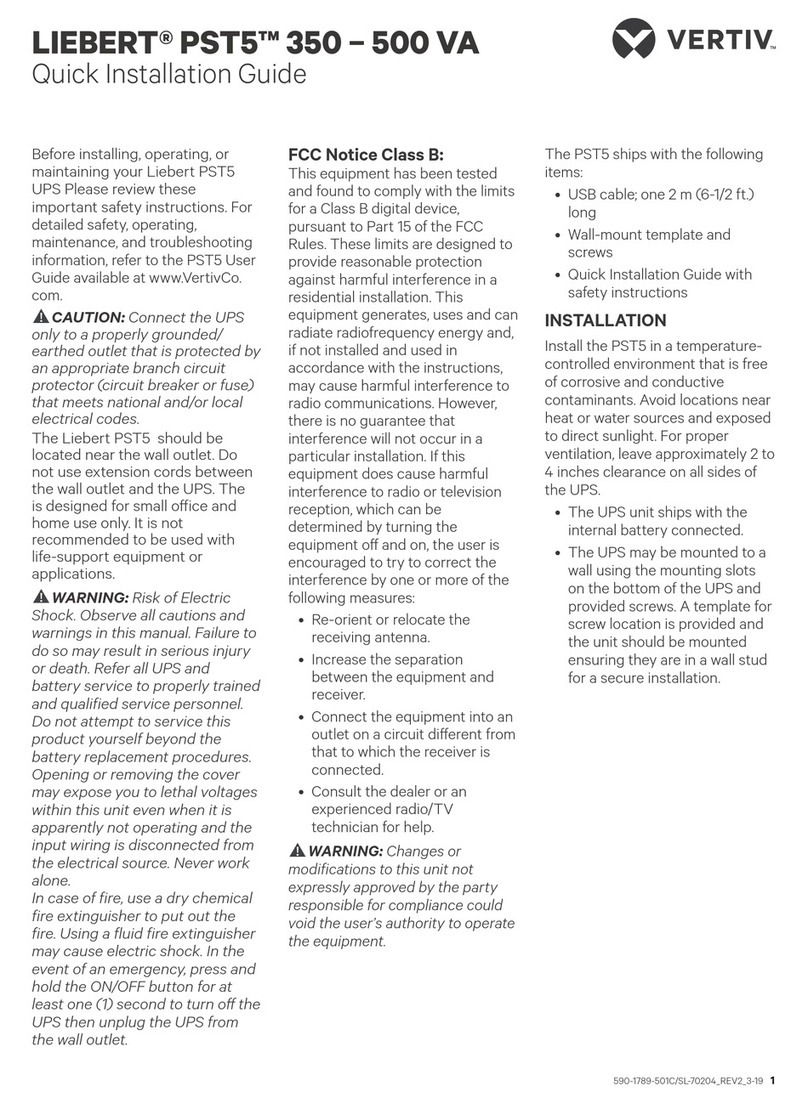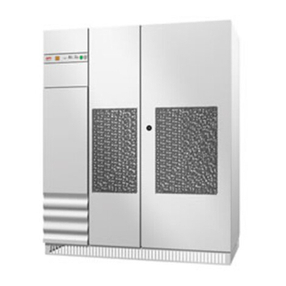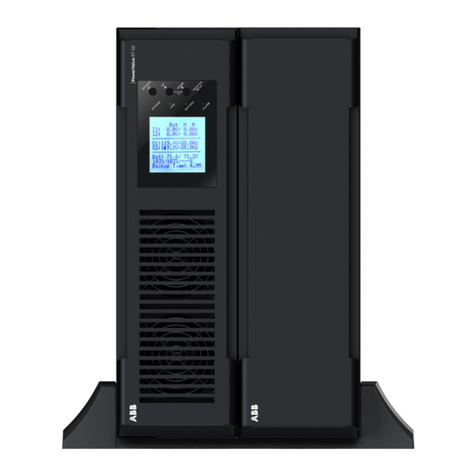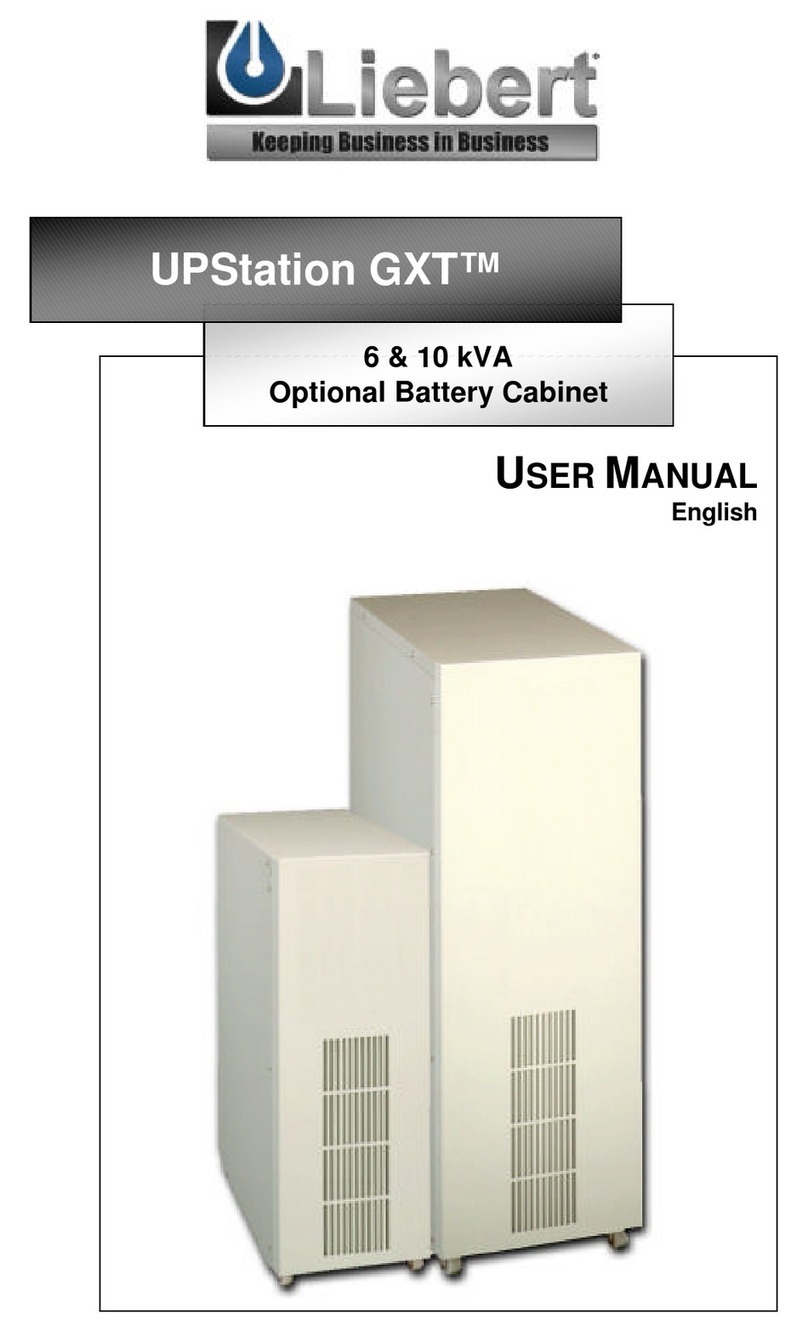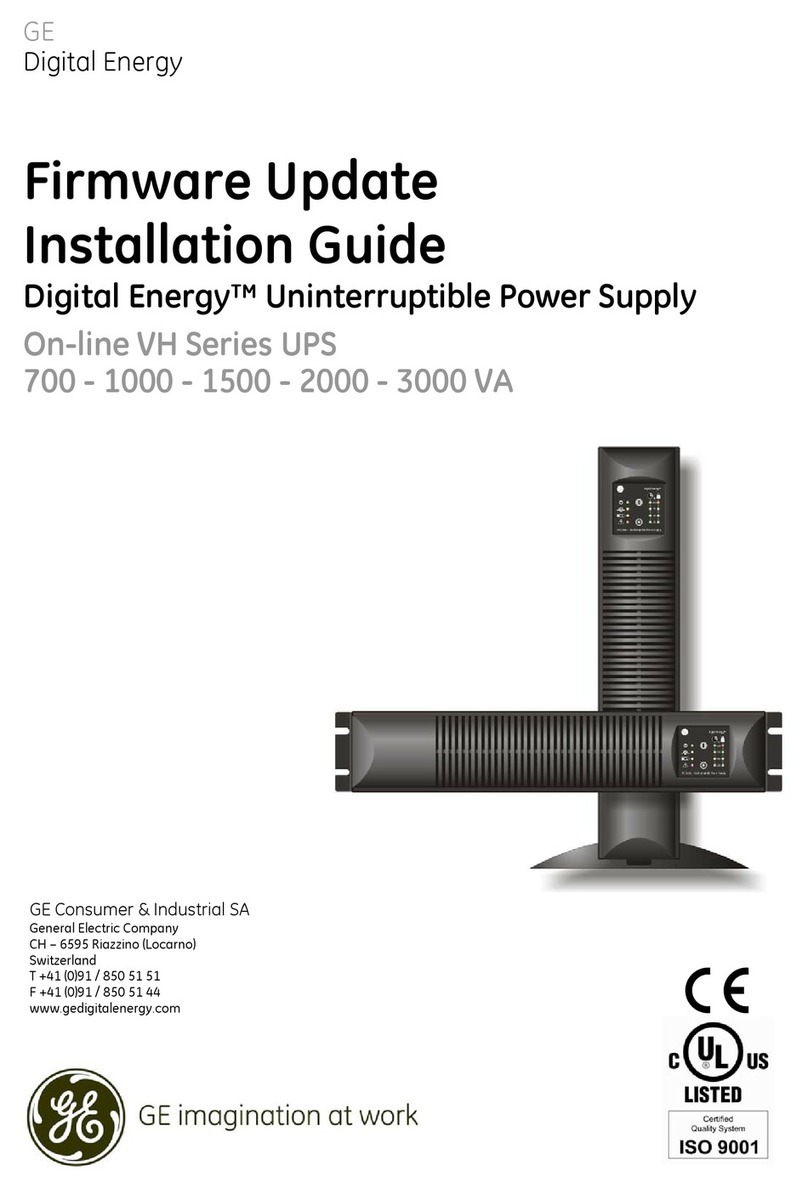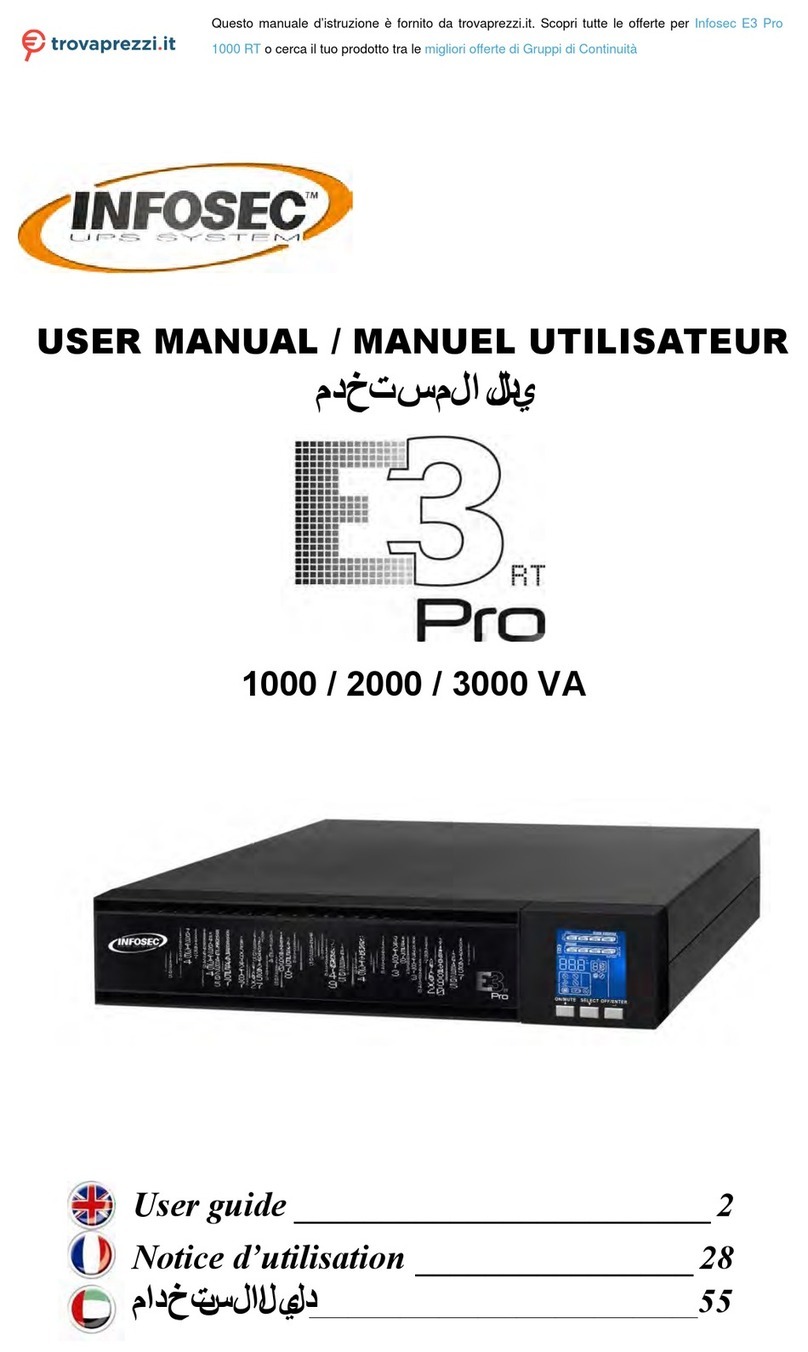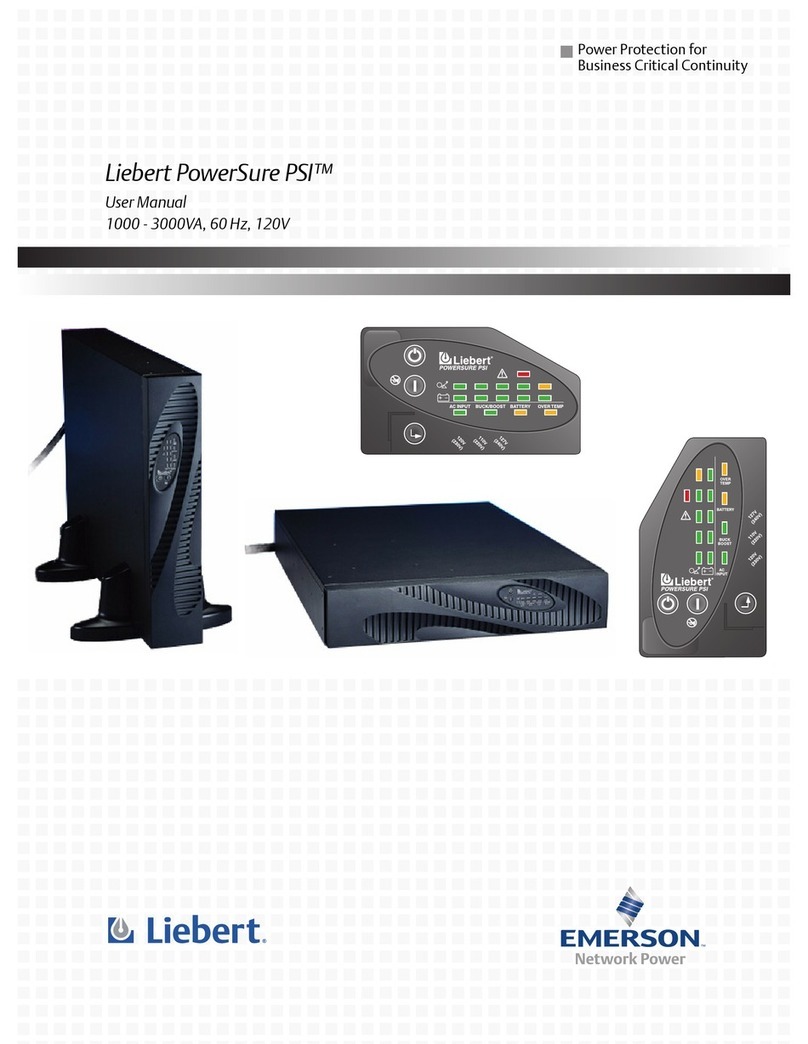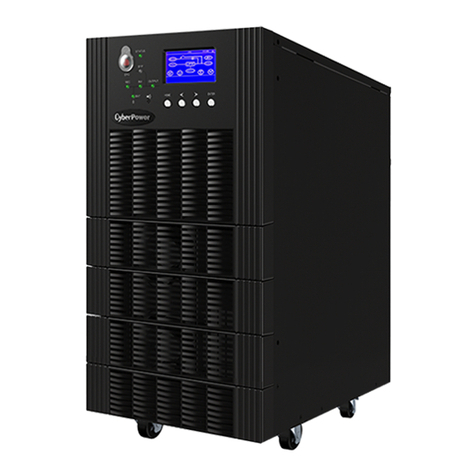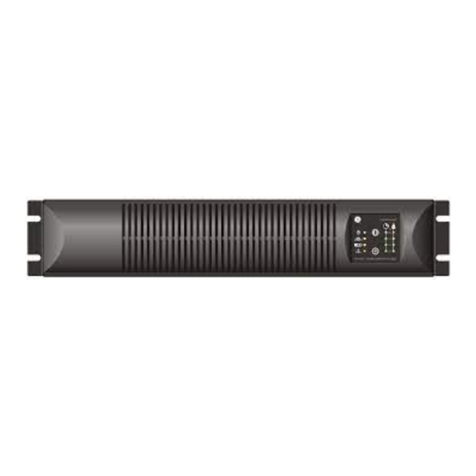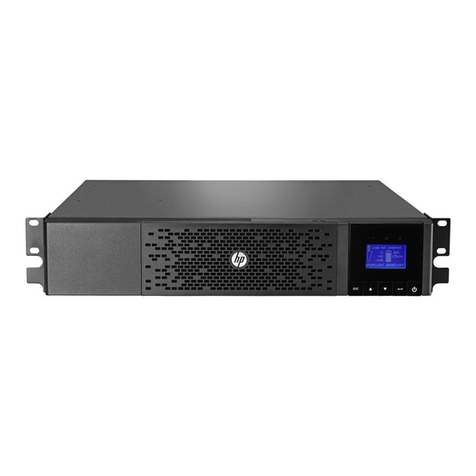EnerSys DataSafe XE User manual

Installation, Operations
and Maintenance
Manual
Visit us at www.enersys.com

Temperature (°C / °F) StorageTime (Months)
OCV Audit Intervals (Months)
+10 / +50 48 12
+15 / +59 34 12
+20 / +68 24 12
+25 / +77 17 6
+30 / +86 12 6
+35 / +95 8.5 3
+40 / +104 6 3
Handling
DataSafe®XE batteries are supplied in a charged
condition and are capable of extremely high short
circuit currents. Take care to avoid short-circuiting
terminals of opposite polarity.
California Proposition 65Warning - Battery posts, terminals, and related accessories contain lead and lead compounds, chemicals known to the State of California to
cause cancer and reproductive harm. Wash hands after handling.
Important
Please read this manual immediately on receipt of the battery before unpacking and installing. Failure to comply with these instructions will render any
warranties null and void.
Care for your safety
2
1. Receiving
1.1. In-Transit Damage or Short Shipments
Upon receipt of the shipment, please check that the items delivered are
undamaged and match the carrier’s Bill of Lading. Report any damage or
shortages to the carrier. EnerSys®is not responsible for shipment damage
or shortages that the receiver does not report to the carrier.
1.2. Shipment Damage or Shortages
Open the shipping containers and check the contents for damage and
against the packing slip. Immediately inform EnerSys of any damaged or
missing items. EnerSys is not responsible for damaged or missing items
after a shipment has been in storage.
2. Storage
2.1. Storage Conditions andTime
If a battery cannot be immediately installed it should be stored in a clean,
cool and dry area. During storage monoblocs lose capacity through self-
discharge. High temperatures increase the rate of self-discharge and reduce
the storage life.
The chart below shows the relationship between open-circuit voltage (OCV)
and storage time at various temperatures.
The maximum storage times before a refresh charge is required and
recommended open circuit voltage audit intervals are:
Monoblocs must be given a refresh charge when bloc voltages approach
the equivalent of 2.10 Volts per cell or when the maximum storage time is
reached, whichever occurs first.
2.2. Refresh Charge
Charge the monoblocs or strings at a constant voltage equivalent to 2.29 -
2.40Vpc with 0.1C10 current available for a period of 24 hours.
2.3. Commissioning Charge
Before commencing operation, the battery must be given a commissioning
charge. The batteries should be charged using constant voltage with a
minimum charge current of 0.1C10 with no load connected to the battery.
Either of the following methods can be used:
• Charge for 7 continuous days at the recommended float voltage of
2.29Vpc at 20˚C / 68˚F or
• Charge for 24 hours at the recommended boost charge voltage of
2.40Vpc at 20˚C / 68˚F. The battery will then be switched over to float
charging, maintaining the battery under floating voltage for 24 hours
before any discharge test.
3. Battery Location
The battery compartment/room must have adequate ventilation to limit
hydrogen accumulation to a maximum of 1% by volume of free air.
Keep flames away
Discharge any possible static electricity from clothes
by touching an earth connected part.
Tools
Use tools with insulated handles.
Do not place or drop metal objects on the battery.
Remove rings, wristwatch and articles of clothing
with metal parts that may come into contact with
the battery terminals.
No smoking, no naked flames, no
sparks
Shield eyes Read instructions
Electrical hazard Danger Re-cycle scrap batteries.
Contains lead
Electrolyte is corrosive
Clean all acid splash in eyes or on skin
with plenty of clean water.
Then seek medical help.
Acid on clothing is to be washed with
water
Warning: Risk of fire, explosion, or
burns. Do not disassemble, heat above
60ºC, or incinerate. Avoid any short
circuit. Metallic parts under voltage on
the battery, do not place tools or items
on top of the battery

3
4. Installation
Install in a clean and dry area. DataSafe®XE batteries release minimal
amounts of gas during normal operation (gas recombination efficiency ≥
95%). They can be installed near the main equipment. Batteries must be
installed in accordance with local, national and international regulations and
manufacturer’s instructions.
nTemperature
Avoid placing the battery in areas of high temperature or in direct sunlight.
The battery will give the best performance and service life when working at
a temperature between 20˚C (68˚F) and 25˚C (77˚F). The maximum operating
temperature range is -40˚C (-40˚F) to + 50˚C (+113˚F).
nVentilation
Under normal conditions gas release is very low and natural ventilation is
sufficient for cooling purposes and inadvertent overcharge, enabling DataSafe XE
batteries to be used safely in offices and with main equipment. However care
must be taken to ensure adequate ventilation when placed in cabinets. Batteries
must not be placed in sealed cabinets.
nSecurity
All installation and ventilation must comply with the current local, national and
international regulations.
nMounting
Battery racks or cabinets, supplied by EnerSys, are recommended for proper
installation. Assemble the rack according to instructions. Place the monoblocs
on the rack and arrange the positive and the negative terminals for connection
according to the wiring diagram. Check that all contact surfaces are clean and
apply the bloc connectors and the terminal screws. Tighten the screws securely.
Follow the polarity to avoid short circuiting of blocs. Finally connect the battery
terminals. It is important that the battery is mounted firmly.
nInstallation of High Voltage Batteries
A battery consisting of 10 or more blocs connected in series presents additional
hazards and the following notes on installation should be employed.
• During installation process, limit the battery voltage by omitting inter-
bloc connectors to give a maximum section voltage of 120V or 10 blocs.
• The omitted inter-bloc connectors should be chosen such that they are
in an easily accessible position. These connectors should only be fitted
with the load and charger isolated and when the rest of the installation
is complete.
• Never work alone on high voltage batteries.
• Always use insulated tools and wear approved high voltage insulating
gloves.
• When supplied, fit the “high voltage battery” warning labels in a
prominent position.
nTorque
Tighten the nuts or bolts to the recommended levels of fastening torque
indicated on the product label (if applicable). A loose connector can cause
problems in charger adjustment, erratic battery performance, possible damage
to the battery and/or personal injury.
nBlocs in Parallel Strings
When using constant voltage chargers, ensure that the connections between
the charger and the end of each string within the battery have the same
electrical resistance. Parallel strings should be limited to five strings.
5. Operation
5.1. Float Voltage
Constant voltage chargers are recommended. The charging voltage should
be set at the equivalent of 2.29Vpc at 20˚C/ (68˚F) or 2.27Vpc at 25˚C
(77˚F). The minimum charging voltage, at any temperature, is 2.21Vpc. The
recommended float voltage temperature compensation is as follows:
Due to the phenomena of gas recombination, it is not uncommon to note a
variation in individual block float voltages of 2% (or up to 5% for relatively
new batteries). However the total voltage of the battery shall be within the
limits stated above.
5.2. Charging Current
Due to the very low internal resistance DataSafe XE monoblocs will
accept very high current during recharge and there is not a need to limit
the available current. For cost and practicle purposes in float applications
where recharge time to repeat duty is not critical, the rectifier current can be
limited to the load plus 0.1C10 Amps.
5.3. Fast Recharge
In instances where the time to repeat duty is critical the charge voltage
should be set to 2.40Vpc at 20˚C (68˚F), with the rectifier current limit set to
a minimum of 0.1C10 A. Fast charge should be stopped and reverted to float
voltage after approximately 10 to 15 hours.
5.4. Periodic Boost Charge
In normal operation a periodic boost charge is not required. However, in
some cases such as when extended or repeated line power outages result
in the battery exeriencing extended periods of undercharging, a boost
charge equivalent to 2.40Vpc at 20˚C (68˚F) for a maximum of 15 hours can
be applied.
5.5. Discharging
For maximum battery life, the end of discharge voltage should be limited
to 1.60Vpc for low rate discharges or 1.50Vpc for high rate discharges
(10 minutes or less in rated duration). Failure to protect batteries from
discharges exceeding this level may impact warranty.
nDischarged Monoblocs
DataSafe XE batteries must not be left in a discharged condition after
supplying the load, but must be immediately returned to float recharge
mode. Failure to observe these conditions may result in greatly reduced
service life and unreliability.
nAccidental Deep Discharge
When the battery is completely discharged, the sulphuric acid is completely
absorbed and the remaining electrolyte consists only of water. At this point,
the sulphation of the plates is at its maximum, considerably increasing the
cell’s internal resistance.
Important notice: this type of deep discharge will provoke a premature
deterioration of the battery and a noticeable effect on life expectancy.
6. Maintenance
In practice, the user usually specifies the maintenance schedule based on
site criticality, location and manpower.
However, the following may be used as a suggested maintenance schedule.
• Monthly (record all readings)
Measure the battery string voltage. If necessary, adjust the float
voltage to the correct value.
• Every six months (record all readings)
- Measure the battery string voltage. If necessary, adjust the float
voltage to the correct value.
- Measure individual bloc voltages.
- Bloc to bloc connection resistance (Ohms)
- Terminal Connection Resistance (Ohms)
- Ambient temperature in the immediate environment
Inspect for contamination by dust, loose or corroded connections. If
necessary, isolate the string/bloc and clean with a damp soft cloth. Warning:
Do NOT use any type of oil, solvent, detergent, petroleum-based solvent or
ammonia solution to clean the battery containers or lids. These materials will
cause permanent damage to the battery container and lid and will invalidate
the warranty.
Keep a logbook to record values, power outages, discharge tests, etc.
An autonomy check can be carried out once or twice a year.
The above record taking is the absolute minimum to protect the warranty.
This data will be required for any warranty claim made on the battery.
Contact EnerSys if you have any questions regarding maintenance.
7. Disposal
DataSafe XE batteries are recyclable. Scrap batteries must be packaged
and transported in accordance with prevailing transportation rules and
regulations.
Scrap batteries must be disposed of in compliance with local and national
laws by a licensed or certified lead acid battery recycler.
Temperature (°C / °F)
10/50 15/59 20/68 25/77 30/86 35/95
40/104
Recommended 2.33 2.31 2.29 2.27 2.25 2.23 2.21
Minimum 2.31 2.29 2.27 2.25 2.23 2.21 2.21

EnerSys World Headquarters
2366 Bernville Road, Reading,
PA 19605, USA
Tel: +1-610-208-1991 /
+1-800-538-3627
EnerSys EMEA
EH Europe GmbH
Baarerstrasse 18
6300 Zug
Switzerland
EnerSys Asia
152 Beach Road,
Gateway East Building #11-03,
Singapore 189721
Tel: +65 6508 1780
© 2016 EnerSys. All rights reserved. Trademarks and logos are the property of EnerSys and its affiliates unless otherwise noted.
Publication No. EN-DS-XE-IOM-001 SEE1555 - March 2016 - Subject to revisions without prior notice. E.&O.E.
Contact:
Table of contents
Other EnerSys UPS manuals
